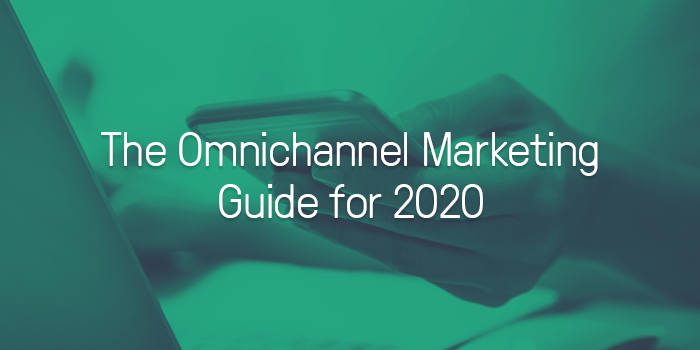The Omnichannel Marketing Guide for 2020
Many businesses want to make the change from multichannel marketing to omnichannel marketing. When you consider the presence, unity, and effectiveness of omnichannel marketing, this makes sense. Different ecommerce marketing channels allow you to communicate with customers, so bringing them together to focus on the customers brings better results.
This is a sponsored or guest post, brought to you by Omnisend. To learn more about sponsored posts and placement opportunities click here.
Even though it’s 2020, your business can start to build your omnichannel marketing strategy. First, you will want to learn about the three steps for implementation.
- Identify Your Buyer Persona
- Choose Communication Channels
- Find Omnichannel Marketing Software
After addressing those initial steps for implementation, we will go over 5 omnichannel practical tactics to apply to your omnichannel marketing strategy.
- Inform Your Team
- Customer Data
- Segment Your Audience
- Adjusting Your Webpage
- Adapt and Improve
Use this guide to help you get started and to see the benefits it can bring to your company.
1. Identify Your Buyer Persona
Your customers have a buyer persona. This means that you have a specific type of customer that your products appeal to. When you identify your buyer persona, you can address these questions to adjust your business to your customers.
- What products have the highest sales from my business?
- If I was a customer, what would I want the business to change?
- What improvements will appeal to my customers?
When you keep your customers in mind and identify their persona, you can build off of that information. Since omnichannel marketing puts customers at the center of the business, you need to think about your customers. This will help you to figure out how you can gear your business towards their needs.
2. Choose Communication Channels
When you get into omnichannel marketing, you need to consider the different channels available and pick ones that your customers will use. Different channels provide various benefits that help your business to communicate with customers.
As you consider your buyer persona, you can identify channels that work for your company. For example, websites, email, and social media are the most effective channels overall. But there is more and more buzz about SMS marketing trend. Make sure to use those channels and to identify other channels that will help your omnichannel marketing strategy.
3. Find Omnichannel Marketing Software
Omnichannel marketing focuses on integrating different channels to make a unified experience for customers. This involves work and making sure that the channels have similar messages and style. This is near impossible for a person to tackle on their own, so getting omnichannel marketing software will help you to set up and implement your strategy.
Having software that keeps everything in one place makes it easier for your business since you can easily access all the necessary information. You can access the software and see how the different channels perform and work together. This simplifies things for you and avoids unnecessary complications when starting an omnichannel marketing strategy.
Now that you know the basic steps to begin omnichannel marketing, here are five key practical tactics to improve and build upon your strategy.
4. Inform Your Team
As you integrate omnichannel marketing into your business, you need to talk with your team and make sure they know about the changes. If people don’t know about the shift, they will keep doing things the same way they did before. By telling them about the change, people can prepare for it, avoid miscommunication, and adjust their current work to fit the new model.
By informing your team, you help yourself and you help them by avoiding the following.
- People not knowing how to handle the new omnichannel marketing strategy.
- People stressed out and not working to their full potential.
- Misunderstandings and mistakes from lack of communication.
Make sure to talk with your team. Tell them what will change and specific details. Let them know how it affects their work and the changes they need to make. This will help them in the transition process and allow them to welcome the change instead of fearing it.
5. Customer Data
As you implement your omnichannel marketing strategy, you can collect data about your customers. You can see how many people visit your website, how many people view your emails, and other important information.
This will inform you about the types of messages that attract customers. When you notice a trend in your customer data, you notice a trend that works and draws in more revenue. Take advantage of those trends so you can maximize your profits.
6. Segment Your Audience
Your audience will have different types of people in it. This includes age, interests, and other demographics. You will sometimes send out messages that apply to some customers but not to others. This is when you segment your audience: you send messages or information to specific groups with the highest chance of responding to get the best results.
You can segment your audience in different ways. The image above gives four suggestions for you to consider when segmenting your audience. The way you do so depends on what you feel will be best for your company. Look at your information and your customers and segment them in a way that will bring you the highest profits.
7. Adjusting Your Webpage
When designing a webpage, you need to think about the different ways that people may look at your website. Not everyone will go on their computer or laptop to view your website, so you need to design it in a way that looks appealing for all formats. This includes mobile devices since many people shop on their phones.
To make sure that your website functions properly on all devices, have people test it out. Try different devices, phone brands, and web browsers to ensure that your website stays consistent. If any of the testers point out errors, mistakes, or inconsistencies, spend some time fixing those things to keep your customers happy.
8. Adapt and Improve
You should always seek to improve your omnichannel marketing strategy. Keep these questions in mind so you can continue to adapt your business to your customers’ needs.
- What are some things my customers like that I should keep doing?
- What do my customers dislike that I should stop?
- How can I adjust the current process to retain more customers?
These are only a few of the questions you can ask yourself to improve your business. As you focus on your omnichannel marketing strategy and look for ways to improve it, you can retain more customers and continue to adapt to their needs. This will show customers that you are mindful of their needs and that they can trust your business.
Final Comments
An omnichannel marketing strategy can seem like a large task at first, but when you break it up into parts, you make it easier to understand. Focus on the initial implementation then use the five tactics to fine-tune your strategy. Doing so will help you to work with an omnichannel strategy in a way that helps customers and your business.




